The iconic 809 Naval Air Squadron, known as the Phoenix Squadron, has been recommissioned as the UK’s second front-line F-35 squadron.
This historic event occurred nearly 41 years after the squadron was disbanded at RNAS Yeovilton.
The recommissioning ceremony, marked by an emotional handover of the unit crest and an F-35 flypast, took place at RAF Marham, attended by friends, family, and VIPs.
Commander Nick Smith, in charge of the squadron’s revival, received the crest from Commander Tim Gedge, the last naval officer to command 809. Commander Smith expressed his honour and privilege in leading the squadron, highlighting its rich history of integration between the Royal Navy and the Royal Air Force. He stated, “The Squadron has a rich history of Royal Navy and Royal Air Force integration… this joint service approach will deliver a world-leading fifth-generation combat air capability, deployable from both land and sea.”
A parade by @RoyalNavy & RAF personnel @RAF_Marham marks 809 Naval Air Squadron's return.
The ‘Immortals’ recommission as the nation’s second front-line F-35B Lightning stealth fighter unit to deliver combat air capability from land or the deck of the QE Class aircraft carriers. pic.twitter.com/3JvQLJRrSK
— Royal Air Force (@RoyalAirForce) December 8, 2023
809 Naval Air Squadron, operating the advanced F-35B Lightning, joins the RAF’s 617 ‘Dambusters’ Squadron as a front-line stealth fighter formation. This new iteration of the squadron continues the legacy of its predecessors, including its involvement in the Falklands Conflict and previous operations using the Blackburn Buccaneer.
The F-35 Lightning, representing a significant generational leap from the Sea Harrier flown in the Falklands, is adaptable for operations both on land and from Royal Navy aircraft carriers. Notably, 809, like 617 Squadron, comprises personnel from both the RAF and Royal Navy, with leadership alternating between the services.
Second Sea Lord Vice Admiral Martin Connell and Air Marshal Harv Smyth, Air and Space Commander, were the guests of honour at the event. Admiral Connell remarked on the proud heritage of the 809 Naval Air Squadron and its role in enhancing the nation’s F-35 combat air force. Air Marshal Smyth added, “When the RAF and RN operate together, the whole is greater than the sum of its parts… equipped with Lightning, it makes for an unbeatable combination.”
809 Squadron’s selection as an F-35 Lightning formation was due to its distinguished history, with battle honours from operations across various regions. The recommissioning expands the UK’s Lightning Force, now comprising four squadrons, including two front-line units, the Operational Conversion Unit (207 Sqn), and the Test and Evaluation Sqn (17).


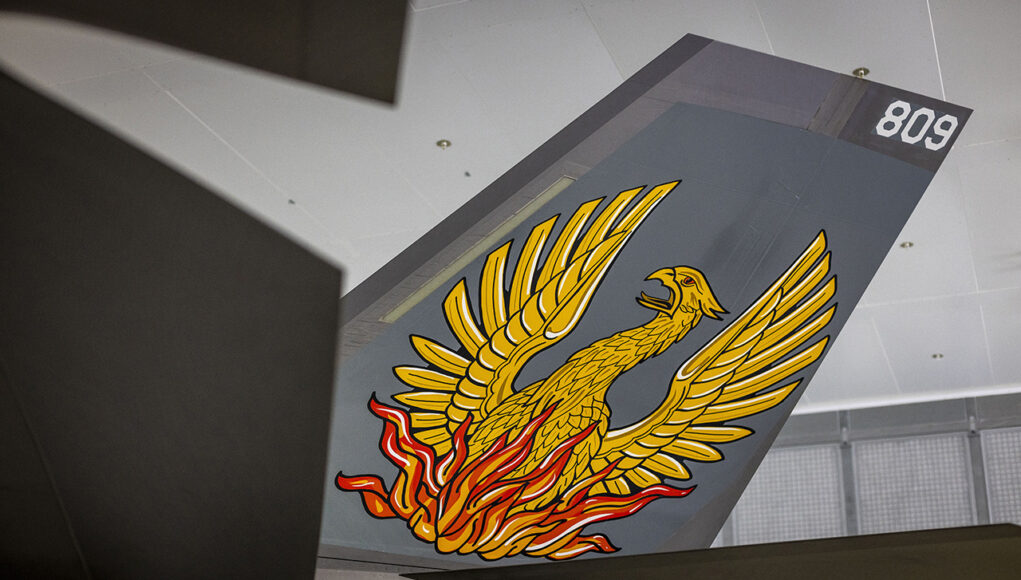
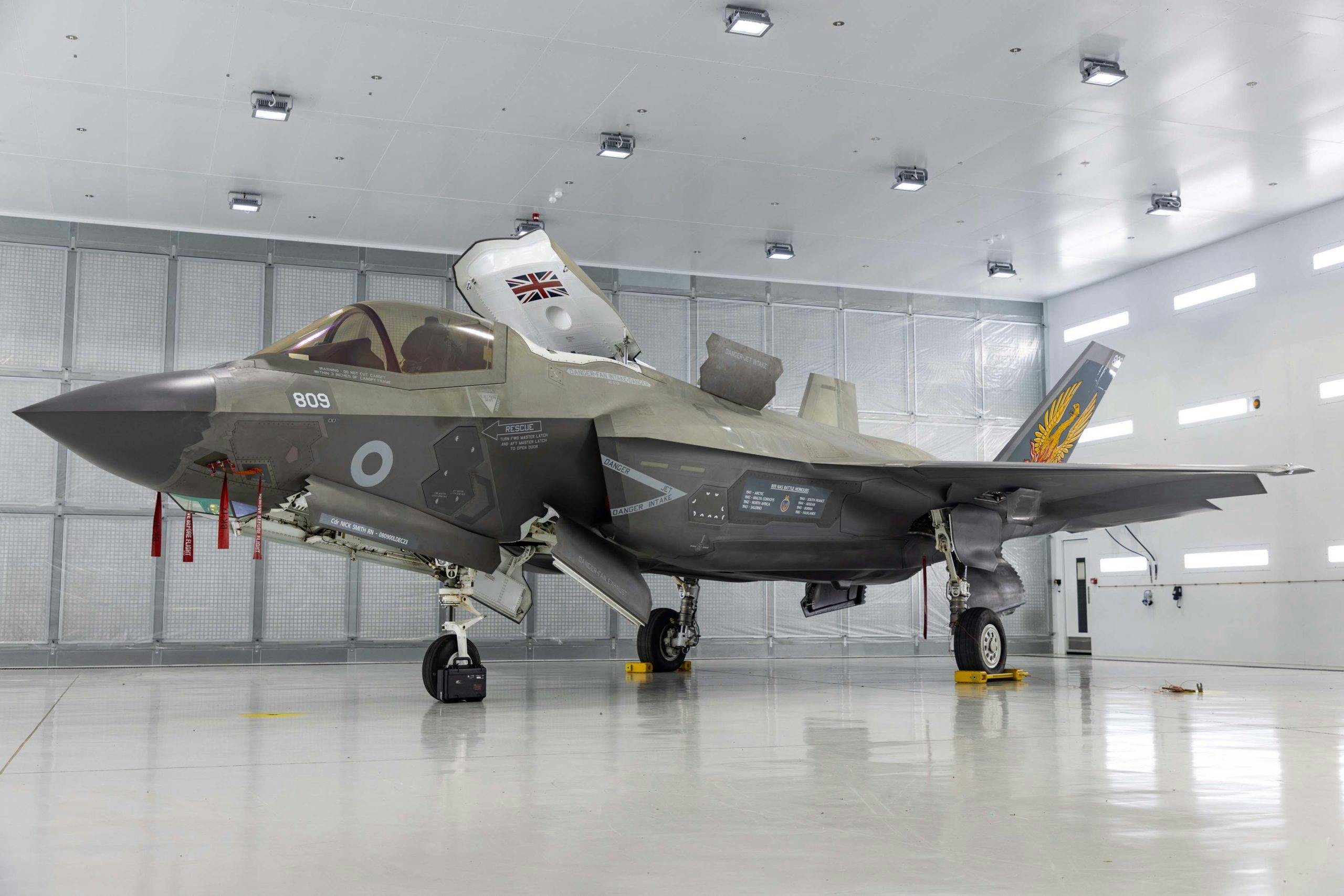

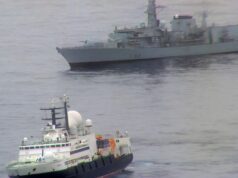
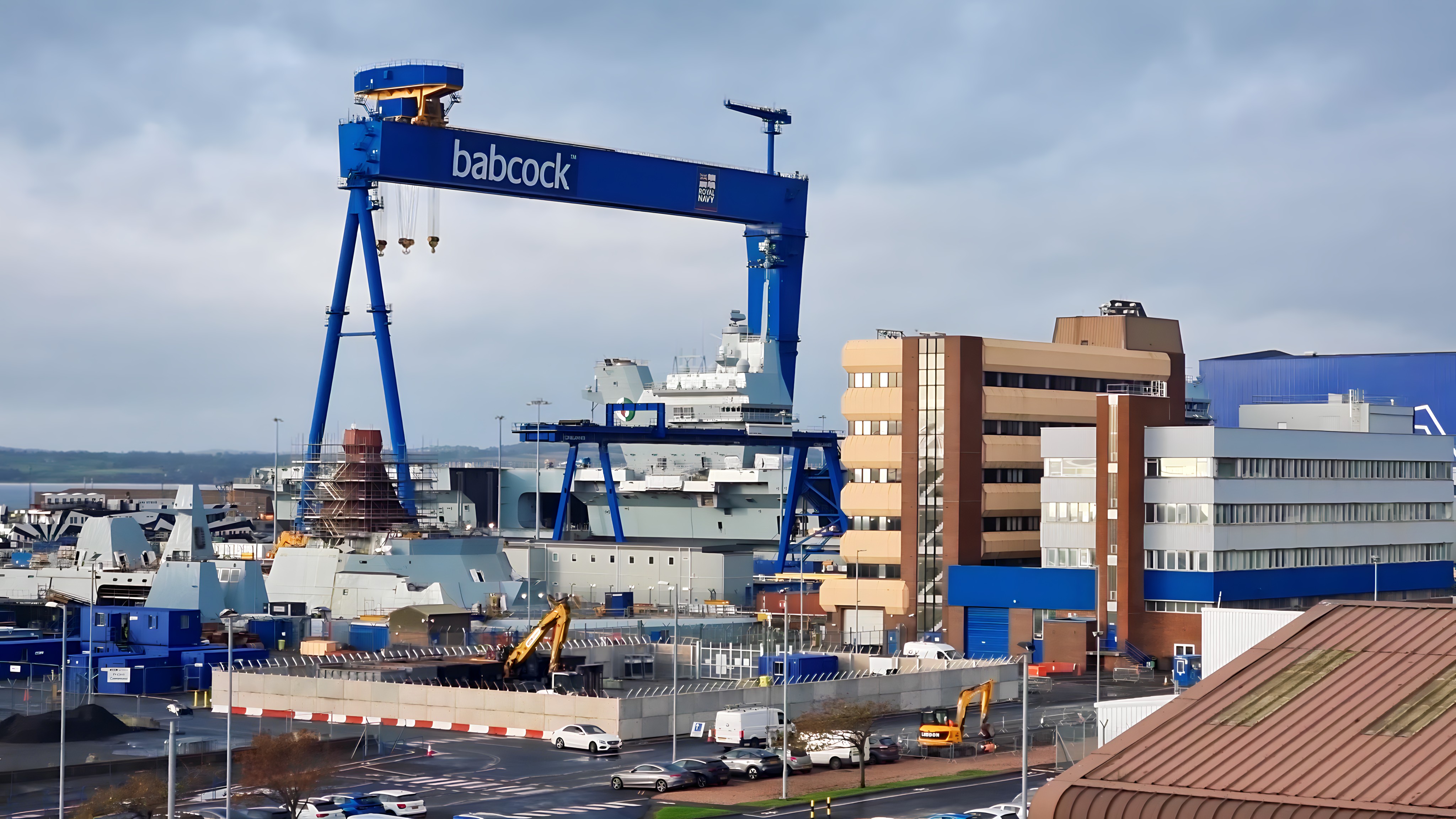
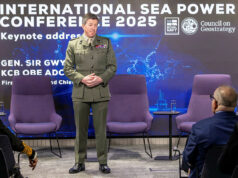
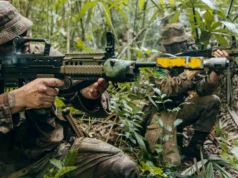

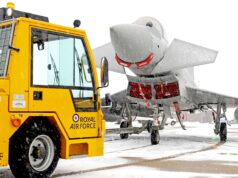
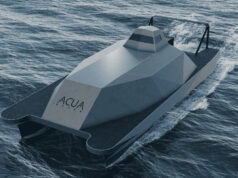
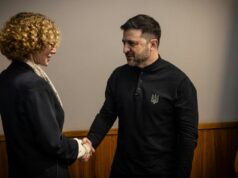


Will it have…. aircraft?
Yes but for 2025.
Thanks
Fitted for, but not with. 🤣
Very good to see, fingers crossed we will see the next carrier group deployment with 2 RN\RAF squadrons and a friend from another nation..I think the RN needs to actually undertake a deployment with three squadrons on board to show the capability ( deterrent ) and actually practice using an Elizabeth with a full air wing.
This is great news, but in reality the UK needs to move to an ambition of 4 F35b front line squadrons..so it can evidence that it can put 3 squadrons up as well as maintain other F35 commitments…the carriers can be a profoundly effective deterrent if they are show to be able to credibly place 3 F35 squadrons on someone’s back yard….
if we have 45 front line airframes by the end of 2025 ( 3 being orange wired) we should be able to stand up three squadrons for 2025-26…if HMG then make sure they have a few more coming in by 2027 ( say another 8 a year) there is no reason why the UK cannot have the four squadrons for 2027….this is important because China is watching the wests capability and china will be at the peak of its power in and around 2027..so deterrent in the 2027-28 time frame is so very very important as we know what china has said it’s going to do.
Great Comment. What I’d like to know is how many Aircraft we assign as a Squadrons Established number ? I know the original idea was 12 to 16 but the USMC has now adapted 10 as their Standard number.
But bottom line is we really do need to order more PDQ, but we also need to accelerate the process to adapt the carriers for light Cat Traps for UAV.
IMHO something like a mix of 16/ 20 F35B, plus 4/6 Sea Guardians, 4/6 MQ-25 Stingrays and 8 AW101 ASW would be a pretty flexible Air group.
The key is using the UAVs as real force multipliers for the F35B.
Hi Rodney, from what I have read the RN/RAF are still planning 12 jet squadrons, which is good news, as you say the USMC are going to 10..but I’m wondering if that is about space on the amphibious ships as much as anything..the USN are moving to a 15 tail squadron for the F35C up from 12 but they are reducing the squadron numbers for a strike wing from 2 to 1.so that means a future USN strike wing will have 1 squadron of 35C ( 15 tails) and 2 squadrons of F18 ( 12 tails each)..for a total of 39 jets ( that’s down from the historic strike wing of 4 squadrons of F18 for a strike wing of 48 jets)…so interestingly it’s likely a Elizabeth carrying its 3 squadrons of f35 will be a more potent strike platform that a U.S. carrier with its one squadron of F35 and 2 of F18.
I do agree the RN needs to work out what it’s UAV package is going to look like…personally I think it may just be a better option to see if the USMC/USN will go in with the UK on developing the V247s tilt UAV..as it could do every role and can even be stuck in a frigate…having a set of V247s for ISTAR, ASuW, ASW,AW, EW,SAR and just moving stuff around..it’s essential a 300-400kn speed 2500mile range large medium rotor.
Orange wired?
The 3 test jets are referred to as orange wired, for the additional test/evaluation kit onboard.
Hi crab, traditionally ( since 1949 anyway) test aircraft with test instruments are wired with a lovely orange wiring…so any orange wired aircraft is basically wired with instruments for test flight and evaluation..not as a production front line aircraft…so the three aircraft the RAF have in the states as part of the test and evaluation centre at Edwards airforce base are orange wired and not deployable.
I know I’m going to get rebuttals. But I find Phoenix is rather too obvious and generic. I mean, at the moment we have a Phoenix squadron and a prototype aircraft for Aeralis called ‘Phoenix’. The tail art is still nice.
Arawn.
Morrigan: A Celtic goddess of war who hovered over the battlefield as a crow or raven. I think that can be used for a UAV.
Cocidius: The goddess of Hunting.
Brigantia: The goddess of war, healing and water.
Boudicca: The British warrior queen prayed to Andrasta before going into battle.
And Cerne Abbas because it would be funny to have that image on the tail.
So many options. That’s not to mention other gods.
From the article, 809 has always been Phoenix, this isn’t a PR stunt it’s just the name of the squadron that has occurred naturally, like 617 are the dambusters.
It would be worse to change the name than to keep it
Wouldn’t mind a Morrigan loitering munition though
Yeah, Morrigan would make a good name for a loitering munition, as well.
Something like a winged quadcopter? Identifies target while hovering then zooms in for the kill
Oh, I thought it was the MOD trying to be clever because it’s a squadron being recommissioned.
Cernunnos, the hunter.
Maybe Wyvern ?
A Wyvern drone, maybe a larger HALE, would be nice
Ahhh yes, the Dragon like predator. Great name.
The hope that we will have 4 frontline squadrons and see 3 squadrons on the Carrier is a flight of fancy.
If the order for an additional 26 goes ahead and we get 74 in total, that will be enough to equip 3 frontline squadrons each of 12 aircraft.
(The remaining 38 will be spread between squadron reserve war reserve, attrition reserve, OEU, OCU and Wingco).
If we want to get 4 squadrons out of that total, they would reduce to 9 frontline aircraft each. That is too puny for the RAF’s interdiction/SEAD role or for its close air support of the army role.
It is frequently overlooked that the RAF has other F-35 roles, the aircraft are not just there to adorn the carrier. Out of the 3 planned squadrons, the mix should be, following the Joint Harrier Wing of old, and adding in the F-35’s valuable additional SEAD capability:
* 1 squadron RAF air operations (interdiction/SEAD)
* 1 squadron RAF close air support of land forces
* 1 squadron Fleet Air Arm for carrier.
Of course, strenuous RN and political efforts are ongoing to switch the balance to the Navy or even to give all the aircraft to the FAA. These efforts should be resisted, the RAF has other air responsibilities. Aircraft on a carrier half way round the world are not much use in the NATO area, which has to be our first priority.
The possibility of ordering yet more F-35bs is a non-starter. They are paid for from the RAF’s budget, which is tightly stretched. First priorities for combat aircraft are the mega-expensive Typhoon ECRS upgrade, the F-35 Block IV upgrade and of course major funding for Tempest. F35B is not on the top list of future air warfare priorities.
The F35 force is a true joint force. The sqns don’t perform different roles. They perform all roles the aircraft is capable of delivering. Which is,the full spectrum of warfare. From air dominace to ISTAR to deep strike and close air support and everything in between.
74 aircraft could actually lead to 4 deployed squadrons…
48 jets
3 operations evaluation
6-8 for OCU
for a total of 59
20% will be off in bits for around 10 airframes being pulled apart
leaving Around 5 attritional reserve..
remember this jet is going to have open production lines for decades…so any attrition during service life can be replaced..
having 20 odd fifth generation jets sitting around in some form of attritional reserve is not really acceptable…
The only way to justify 3 squadrons with 74 airframes is if they up the number of jets in each squadron to 15-16 jets…we went through bucket loads of harriers and had a decent attritional reserve is because the constantly fell out the sky and broke themselves.
There is no chance you’ll get 4 squadrons unless tranche 2 is increased or squadron sized decreased.
48 operational + 8 OCU + at least 12 in use reserves but preferably more leaves 6 in the maintenance pool. Nowhere near enough. To add to that, the three orange wire, and BK3 will disappear when TR4 comes around leaving 70 in the fleet. An increase to 90 aircraft would scrape 4 frontline squadrons.
The MOD have realised 74 won’t get them 4 squadrons which is why the scope has been reduced from 4×12 to 3×12-16 which really means 3×12.
F35B will not be in production for decades, once the USMC order wraps up there won’t be any further orders, the USMC are already looking to shrink their force to 299 albeit by retiring older aircraft. F35A is the only variant that will be in production for decades to come.
Could you not have the RAF squadrons with 9 aircraft and the Faa squadrons with 10? Or the other way round that would make 42 operational aircraft.
Gosh Jonathan, you really must write to the Air Staffs and Lord Trenchard’s great grandchildren to let them know that they’ve been getting their squadron structure wrong all these years!
Except that they haven’t, the RAF format has been copied worldwide, because it is a proven model that works.
There are no aircraft ‘sitting around’, those in frontline and reserve are rotated regularly to even out the flying hours. In this way, the fleet’s life is maximised.
I think you have missed that a frontline squadron of 12 actually has 15 aircraft on its strength. They are technically complex aircraft and systems which need a lot of checks and maintenance. The 3 extra aircraft are cover for those in maintenance, so that the squadron can actually get 12 in the air if called for.
There is a small war reserve to cover early losses in a shooting war. If you remember the Tornados downed by enemy ground fire in the opening weeks of Gulf War 1, you will appreciate that a ready reserve is essential to maintain squadron strength.
The OCU is not 6-8 aircraft, it is 8. One training for every 6 frontline/ squadron reserve plus 10% attrition = 8.25, call it 8.
Whether or not you follow it, 50% of a fast jet fleet are in the frontline and 50% are training and reserve.
Look at the Typhoon fleet – 5 squadrons each reduced to 10 aircraft + 3 frontline in Falklands = 53. Out of 107 aircraft. That is again 50% of the FG4 fleet.
The reason why they include a small attrition reserve at the outset is because the production line is likely to close within the service life of the fleet or to be offering a different model at a much higher price.
I think Trenchard and the staffs thought this one through…
WWII maths sometimes needs a rethink.
Frames are now £80m+ so a lot more than a Spitfire……
Base and ground crew costs are orders of magnitude higher.
Squeezing a few more drops out of an orange is therefore important.
That said the 101 management consultancy level maths used by MID to cost work streams isn’t up to much either.
thats an excellent point SB, overlooked by most
Cripes, things change and change is not a dirty word…just because “we alway have” his a very bad reason to do something in the same way …once we would produce huge numbers of airframes and had them sitting around…that’s is just not something that can be done with fifth generation aircraft, that are just to costly and a rare resource.
maybe a look at the USMC and how they do it would maybe help the use our nations assets more effectively.
The US marines have 10 airframes in a squadron, that is it no more no less. Those squadrons are in a division of 2 squadrons and theta division has exactly 2 spare airframes…no more no less the USMC runs on a maintenance and attrition reserve of 2 airframes for 2 squadrons of of 10…so a maintenance reserve of 10%. ( so effectively each squadron has 11 airframes..to operate a 10 tail squadron.
in the end the I believe USMC plan to run around 18 squadrons of F35b with 2 squadrons that our the equivalent of the OCU with a total through life buy of 353 aircraft so the have 4.6 (ish) times the number of jets we will have but 6 times the number of squadrons..I may be wrong but it’s seems like the USMC will be sweeting their assets more than the RAF…the marine corps have been very honest in that they have significantly truncated their attritional reserve and mantanance pool due to the cost of 5th generation aircraft..
As for production line yes it will close during the service life of the F35B but that service life is likely to be 50 years and we are very likely to undertake a later buy..the reality is the F35 production line is going to be running for decades and we have those decades to buy more if we wish..the early blocks of the F35b ( the first 48 aircraft ) will likely be replaced at some point in the future…it is better to order what you need later than build up an attritional reserve earlier in the aircraft’s life. This is specifically true of F35 where block 4 is going to be so important…it’s why no government is going to come out and say we are not committed to the final 130ish buy…they don’t know what they will need to buy in 15-20 years to replace old and knackered airframes.
How would loyal wingmen work with squadron mass? Would they be part of the squadron or attached from a different squadron? And what would each of those do to numbers on a carrier and off it? What do you think.
Gedge would have needed his spare sock at the event – what’s the chance that such a brilliant leader wanted to take one up?
Just in time for Xmas 🎅 let’s hope all goes well for 809sqn . And Santa brings us more SQNs for the future 🙏 🇬🇧
Yep Andrew D, the Imortals fly again. Chuffed to bits. 🛫😁👍.
Can we have the Omega Sqn rom the old Ark Royal…
That would be cool,James
And the planes for them to operate.